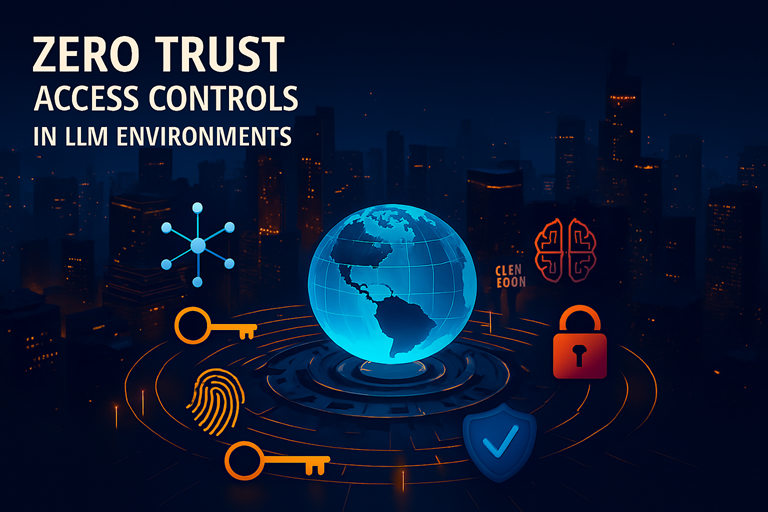
Status: Final Blueprint
Author: Shahab Al Yamin Chawdhury
Organization: Principal Architect & Consultant Group
Research Date: 2 August 2025
Location: Dhaka, Bangladesh
Version: 1.0
1. Executive Summary: The New Security Imperative for AI
The rapid enterprise adoption of Large Language Models (LLMs) has created a new, complex attack surface that traditional perimeter-based security cannot defend. Zero Trust Architecture (ZTA), based on the principle of “never trust, always verify,” is the strategic imperative for securing these dynamic, data-centric AI ecosystems. This blueprint provides an actionable strategy for implementing Zero Trust controls across the entire LLM lifecycle.
Key Findings:
- Identity is the New AI Perimeter: Every entity, including AI agents and services, requires a strong, verifiable identity.
- The LLMOps Lifecycle is a Security Kill Chain: Vulnerabilities introduced at any stage, from data collection to deployment, can lead to catastrophic failures.
- Data-Centric Security is Non-Negotiable: Protecting prompts, responses, and training data requires a data-first security strategy.
- AI-Powered Attacks Demand AI-Powered Defenses: A dynamic, adaptive ZTA that uses AI to power its own policy engine is the future of LLM security.
C-Suite Recommendations:
- Mandate a Zero Trust Strategy for all AI initiatives.
- Prioritize Investment in modern Identity and Access Management (IAM) for AI agents.
- Champion a Phased, Maturity-Driven Implementation to manage costs and deliver incremental value.
- Establish a Cross-Functional AI Security Governance Body to oversee policy and risk.
2. Core Zero Trust Frameworks for AI
A successful ZTA implementation synthesizes established industry and government frameworks:
- NIST SP 800-207: Provides the foundational philosophy of ZTA, focusing on protecting resources (data, models, APIs) rather than network perimeters. Its seven core tenets guide the architecture.
- CISA Zero Trust Maturity Model (ZTMM): Offers a practical, phased implementation roadmap across five pillars: Identity, Devices, Networks, Applications & Workloads, and Data.
- Forrester ZTX: Extends Zero Trust principles across the entire technology stack, emphasizing automation and API integration, which is critical for modern LLM architectures.
- Gartner ZTNA: Defines a specific technology category for providing secure, application-level remote access, replacing legacy VPNs for developers and administrators.
3. The LLM Attack Surface & LLMOps Lifecycle
Security controls must be mapped to the end-to-end LLMOps lifecycle to be effective.
LLMOps Stages:
- Data Collection & Preprocessing: Ingesting and cleaning data.
- Model Training / Fine-Tuning: Training or adapting the model.
- Evaluation & Refinement: Testing for performance and safety.
- Deployment & Inference: Serving the model via an API.
- Monitoring & Maintenance: Observing performance and detecting drift.
OWASP Top 10 for LLMs: This framework identifies critical vulnerabilities. Key threats like Training Data Poisoning (LLM03) occur early in the lifecycle, while Prompt Injection (LLM01) and Insecure Output Handling (LLM02) are primary threats at the inference stage. A holistic ZTA must apply controls at every stage to be effective.
4. Pillar-by-Pillar Implementation Guide
- Pillar 1: Identity:
- Establish a unified Identity Provider (IdP) for all human and machine entities.
- Enforce phishing-resistant Multi-Factor Authentication (MFA) for all human administrators.
- Assign strong, verifiable identities to all AI agents and workloads using standards like OAuth 2.0.
- Pillar 2: Devices:
- Maintain a real-time inventory of all devices accessing LLM resources.
- Enforce device health and compliance as a condition for access.
- Isolate unmanaged and BYOD devices using Virtual Desktop Infrastructure (VDI) or browser-based access.
- Pillar 3: Networks:
- Implement macro-segmentation to isolate the entire LLM environment from the corporate network.
- Use micro-segmentation to create granular security zones aligned with LLMOps stages (e.g., separating training data from inference endpoints) to prevent lateral movement.
- Encrypt all traffic, including internal “East-West” traffic between microservices.
- Pillar 4: Applications & Workloads:
- Use an API gateway as a Policy Enforcement Point (PEP) for authentication, rate limiting, and input validation.
- Rigorously sanitize all user prompts to defend against prompt injection attacks.
- Secure the software supply chain by continuously scanning all components, including base models and libraries, for vulnerabilities.
- Pillar 5: Data:
- Implement automated data discovery and classification to identify and tag sensitive information.
- Enforce data access policies based on data classification and the context of the request.
- Use Data Loss Prevention (DLP) to scan both prompts and responses to prevent sensitive data leakage.
5. Advanced Controls & Future-State Architecture
- Privacy-Enhancing Technologies (PETs): For highly sensitive data, use Confidential Computing to encrypt data while it is being processed in memory, protecting it from compromised hosts or cloud providers.
- AI-Driven Policy Engines: The future of ZTA is an adaptive, learning system. Use AI and behavioral analytics to establish baselines of normal activity and dynamically adjust risk scores and access policies in real-time.
- Explainable AI (XAI): Integrate XAI to provide clear, human-readable justifications for security decisions (e.g., why an access request was denied), which is crucial for auditing and incident response.
6. Measuring Success: KPIs and ROI
The success of the ZTA program must be quantifiable. Track metrics across three key areas:
- Security Posture:
- Mean Time to Detect/Respond (MTTD/MTTR) for LLM-specific incidents.
- Reduction in audit findings related to access controls (target 60-85% reduction).
- Operational Impact:
- Inference latency overhead introduced by security controls (target <50ms).
- Percentage of security alerts resolved via automation (target >80%).
- Business Value & ROI:
- Reduced breach costs (average savings >$1M annually for mature ZTA).
- Accelerated time-to-market for new AI features (target 20-45% faster).